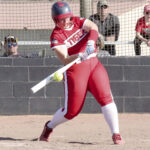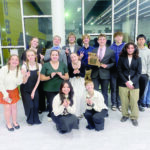Driving around Cassville the morning of May 26, about five hours after a severe storm and in traffic nearly as thick as Saturday’s Memories Cruise, I thought I was witnessing the worst storm damage Cassville had seen in a long time.
From the Barry County courthouse north to Pilant Cemetery and east down 13th Street, the scenes of wreckage were tough to miss.
Earlier that morning, the storm’s thunder and heavy hail woke my family up. I typically keep a beat in incoming storms — especially severe ones — but I was not expecting what came through at 3 a.m. that day.
Looking out the front windows of our house during the event, we couldn’t see more than a couple of feet. It took an illuminating flash of lightning for my wife to see one of the two trees in our front yard, maybe 50 feet from the window, had snapped in half and sprawled across the street.
It was one tree of at least a dozen in our small neighborhood that bit the dust, including an oak with a 10-foot root ball and trunk as wide as the cars in nearly missed.
Throughout town, the trees and power poles got the worst of it. Homes in the Sherwood Forest neighborhood on the north end of town and the city’s hilltops — like on Sky Street and down Y Highway — sustained the most crippling damage.
After the storm ended and cleanup began, the same two questions continued swirling around the community: was it a tornado and why were there no sirens?
Two days after the storm, the National Weather Service in Springfield completed a survey of the damage, determining the storm produced wind gusts of 70-80 miles per hour — but no tornado.
The reaction to the announcement carried the same energy as the reaction to Dr. John Forsyth’s death being ruled suicide — disbelief.
I have lived here 10 years, and this was the worst damage I had ever seen in Cassville. Many of my friends who have lived here decades longer than I have said the same.
In my time here, I’ve reported on a handful of confirmed tornadoes, in Butterfield, Wheaton, Seligman and Monett if I remember them all correctly, and all of those have been EF-1 (86-110 mile per hour wind) or smaller.
As I went through the city taking photos, here’s what I noticed. First, damage was mostly limited to trees. There were a couple places in town with roof damage, like at the Main Street and Highway 112 intersection, but most of the damage to structures was caused by falling trees. The vast majority of those trees also went down in the same direction, falling east.
The NWS saw the same thing. What they did not see is a tornado path, which sends trees in all directions. Radar did not indicate rotation, but did indicate heavy winds. The NWS’ specific determination was a downburst, which is a column of air dropping out of a storm and dispersing across the land like a faucet would disperse water.
With most the damage oriented east to west, power poles on Highway 76 toward Exeter falling to the south and a damage path near Shell Knob that was five miles wide, the physical evidence points to the NWS decision being correct. If there is concrete evidence of a tornado path, I have not seen it, and I have looked.
While there may not have been rotation enough for a tornado, the first-person accounts of those most affected sure say it sounded like it was. And that’s valid, too.
The NWS reported wind gusts of 70-80 miles per hour, but Emergency Management Office Director David Compton said he thought some gusts could have been 85 miles per hour — the same speed as an EF-0 tornado, just blowing differently.
The NWS saw no rotation on radar when the storm was in Barry County, nor did Compton. Both said as the storm approached Cassville, wind speed picked up greatly, too quickly for any kind of local action to be taken.
The NWS issued a severe thunderstorm warning about 20 minutes before the storm, noting possible wind gusts of 70-plus. Compton said at the time they realized how heavy the wind had gotten, sounding sirens would have led people to go out into the worst of the storm. The NWS cannot direct the county to sound any sirens.
I always say major storms have a tendency to skirt around Cassville, theorizing the change in elevation and Cassville’s valleys keep storms from gaining as much traction. According to the NWS, data shows less tornadic activity close to the Arkansas state line, in the lowest parts of the county.
Whether straight-line winds or a small tornado were the cause, one thing is clear — this was a once-in-alifetime weather event in Cassville. Incredibly, and very fortunately, no one was injured as a result. For that, we should be most thankful.
The storm has also brought out the best in our community, with people supporting one another in more ways than I can count. From chainsaw work to hauling brush, food and housing assistance and more, Cassville is showing the best way out is through.
In the aftermath, recovery continues. This week, Compton hopes to get a federal disaster declaration, which would open up much-needed funding that will help ease the burdens placed on those most affected.
Our trees may be down, but we are not out.
Kyle Troutman has served as the editor of the Cassville Democrat since 2014 and became Publisher in 2023. He was named William E. James/Missouri Outstanding Young Journalist for daily newspapers in 2017, and he won a Golden Dozen Award from ISWINE in 2022. He may be reached at 417-847-2610 or ktroutman@cassville- democrat.com.







